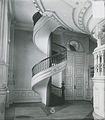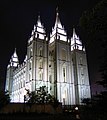Salt Lake Temple


The Salt Lake Temple is the most famous and largest temple of The Church of Jesus Christ of Latter-day Saints (commonly known as " Mormons "). The building is built in different styles of historicism and is located in Salt Lake City , the capital of the US state Utah .
history
On February 14, 1853, the site for the temple was assigned. The foundation stone was laid by Brigham Young . The official start of construction was on April 6, 1853 (the anniversary of the Mormons' founding of the church). First, sandstone from a local quarry was used, but this turned out to be too brittle and therefore unsuitable.
From 1858, granite was used from Little Cottonwood Canyon - around 30 km southeast of the construction site. The transport was carried out with ox carts. From 1869 it was transported by rail. The construction was delayed again and again and came to a complete standstill during the state persecution of the Mormons in the 1880s. After the abolition of polygamy in 1890 and the associated end of persecution, construction was accelerated again. When the construction was finally completed, Wilford Woodruff dedicated the temple on April 6, 1893; exactly forty years after construction began. The temple is 64 m high and has a floor area of about 23,500 m². It is the heart of the 40,000 m² Temple Square . As with all temples in this church, entry is only permitted to church members with a valid letter of recommendation from their own bishop.
The openly accessible Main Street Plaza in front of the temple was sold by the city to the Mormons for $ 8.1 million in 1999 , making it private property on which community codes of conduct apply as soon as they are signposted or the reservation of title is clearly indicated . In September 2009, the information signs at the entrances were expanded to include the following addition: “Private property. The Church reserves the right to refuse entry to anyone for any reason. ”The American Civil Liberties Union of Utah said this was a good start and would like a list of the rules, possibly on the Church's website. The reason for these actions was a kissing gay couple, who were expelled from the court and who refused to be charged with property damage.
On March 18, 2020, the statue of the angel Moroni lost its trumpet in an earthquake measuring 5.7 M w .
symbolism
The Salt Lake Temple contains many symbolic jewelry as well as symbols of the Masons . Symbolism is an important issue in the Mormon faith. These are the symbols that adorn the temple:
- Eye of Providence - The central tower has an Eye of Providence that shows how God sees everything.
- Angel statue - The golden angel Moroni on the spire symbolizes the angel from Rev 14.6 EU , who announces the Parousia .
- Beehive - The beehive (which is on the Utah state seal ) appears on exterior doors and doorknobs and symbolizes Mormon ingenuity, hard work, perseverance, and neatness.
- Big Bear - On the west side of the temple appears the Great Bear , this symbolizes the priesthood that can show the people the way to heaven. Just as the pole star can show people the way.
- Angle and Compass - Early plan drawings show the Masonic symbol angle and compass on the windows of the second and fourth rooms, but these plans were changed during construction. These symbols were on the Nauvoo Temple weather vane .
- Shaking hands - there is a " handshake " above every outside door and every doorknob . This is a representation of brotherly love and the covenants made in the temple.
- Clouds - Clouds are raining down on the east side of the temple. They refer to the ongoing revelation of God, his talking to people speaks that shows the veil and sin.
- Earth - The earth stones at the bottom show how the gospel is spread over the whole earth.
- Saturne - Early drawings and written descriptions showed Saturn stones on the top step of the temple, but the design was modified years later.
- Spirals - The six spirals testify to the power of the priesthood . The three spirals on the east side are a little higher than those on the west side. They represent the Melchizedek , or “higher priesthood,” and the Aaronic , or “preparatory priesthood.” The three spirals on the east side represent the First Presidency and the twelve smaller spirals represent the Quorum of the Twelve Apostles .
- Sun, Moon, and Stars - There are some stones around the temple that represent the sun, moon, and stars. This is meant to represent a representation of the kingdoms of glory in the afterlife.
Photographs of the interior
In response to a member who posted unauthorized pictures, church leaders decided to publish The House of the Lord in 1912. This contains the authorized images shown below.
the Holy of Holies
Bomb attack in 1962
On November 14, 1962, a bomb attack was committed on the south door of the temple. FBI agents found that explosives had been wrapped around doorknobs . People were not harmed in the attack.
Data and photos
- Announcement: July 28, 1847
- First groundbreaking: February 14, 1853
- Dedication: April 6, 1893
Other buildings on Temple Square
Web links
Individual evidence
- ↑ Fair warning ( Memento of the original from March 1, 2016 in the Internet Archive ) Info: The archive link was inserted automatically and has not yet been checked. Please check the original and archive link according to the instructions and then remove this notice. , The Salt Lake Tribune, July 30, 2009
- ↑ Rosemary Winters, Melinda Rogers: Prosecutor drops case against gay couple accused of trespassing on LDS property ( Memento of the original from July 31, 2009 in the Internet Archive ) Info: The archive link was inserted automatically and has not yet been checked. Please check the original and archive link according to the instructions and then remove this notice. , The Salt Lake City Tribune, July 30, 2009
- ↑ LDS plaza video shows scuffle, but no kiss ( Memento of the original from July 31, 2009 in the Internet Archive ) Info: The archive link was inserted automatically and has not yet been checked. Please check the original and archive link according to the instructions and then remove this notice. , The Salt Lake Tribune, July 31, 2009
- ↑ Rosemary Winters: LDS Church posts tougher signs on plaza ( Memento of the original from February 13, 2010 in the Internet Archive ) Info: The archive link was inserted automatically and has not yet been checked. Please check the original and archive link according to the instructions and then remove this notice. , The Salt Lake Tribune, September 29, 2009
- ^ Daniel Burke: Utah earthquake damages Mormon temple and knocks trumpet from iconic angel statue. In: cnn.com . March 18, 2020, accessed on March 19, 2020.
- ↑ Michael W. Homer: 'Similarity of Priesthood in Masonry': The Relationship Between Freemasonry and Mormonism . In: Dialogue: A Journal of Mormon Thought . 27, No. 3, Fall 1994. Retrieved July 8, 2017.
- ↑ a b c d e f g h i j Allen D. Roberts: Where Are the All-Seeing Eyes? The Origin, Use, and Decline of Early Mormon Symbolism . In: Sunstone Magazine . 1, No. 49, May 1985. Retrieved June 25, 2017.
- ↑ Why Symbols? . February 2007. Retrieved October 11, 2012.
- ↑ Allen H. Berber: Celestial Symbols: Symbolism in Doctrine, Religious Traditions and Temple Architecture . Horizon Publishers, April 4, 2006, ISBN 0-88290-808-1, (accessed July 10, 2017).
- ↑ Oldest Artwork on Temple Square . LDS Church Deseret Management Corporation. Retrieved July 8, 2017.
- ↑ Salt Lake Temple p.47 . University of Utah. Retrieved July 8, 2017.
- ↑ M. Guy Bishop, Richard Neitzel Holzapfel: The 'St. Peter's of the New World ': The Salt Lake Temple, Tourism, and a New Image for Utah . In: Utah Historical Quarterly . 61, Spring 1993, p. 33. Retrieved July 8, 2017. Page 33 archived here .
- ^ Richard G. Oman: Beehive Symbol . Brigham Young University. Retrieved June 25, 2017.
- ^ Truman O. Angell : The Temple: To the Editor of the Deseret News . S. 2. August 17, 1854. Retrieved August 19, 2014: "Moral, [of Ursa Major is that] the lost may find themselves by the Priesthood"
- ^ Dean R. Zimmerman: The Salt Lake Temple . In: The New Era . June 1978. Retrieved July 10, 2017.
- ^ Richard G. Oman, Exterior Symbolism of the Salt Lake Temple: Reflecting the Faith that Called the Place into Being . In: BYU Studies Quarterly . 36, No. 4, 1996. Retrieved July 10, 2017.
- ^ Richard O. Cowan: Latter-day Saint Temples as Symbols . In: Journal of the Book of Mormon and Other Restoration Scripture . 21, No. 1, 2012. Retrieved July 10, 2017.
- ^ Symbolism Can Be Seen in Architecture of SL Temple . In: Mormon Times , LDS Church, November 27, 2008. Retrieved July 10, 2017.
- ↑ Richard Neitzel Holzapfel: Every Window, Every Spire Speaks of the Things of God . In: Liahona . November 1993. Retrieved July 10, 2017.
- ^ Laurel B. Andrew: The Early Temples of the Mormons: The Architecture of the Millennial Kingdom in the American West , 1st. Edition, State University of New York Printing, June 1978, ISBN 0-87395-358-4 , pp. 84-85 (accessed June 25, 2017).
- ↑ Kent Walgreen: Inside the Salt Lake Temple: Gisbert Bossard's 1911 Photographs . In: Dialogue: A Journal of Mormon Thought . 29, No. 3, Fall 1996. Retrieved July 8, 2017.
- ^ A b Nelson B. Wadsworth: Set in Stone, Fixed in Glass . Signature Books, Salt Lake City September 1992, ISBN 1-56085-024-8, (accessed July 8, 2017).
- ↑ a b James Talmage: The House of the Lord: A Study of Holy Sanctuaries Modern and Ancient . Deseret News, Salt Lake City 1912 (Retrieved July 9, 2017).
- ^ Bridger Talbot: The Evolution of Sacred Space: The Changing Environment of the Endowment . In: Front Matter: 2014 BYU Religious Education Student Symposium . 2014. Retrieved July 9, 2017.
- ↑ Brittany Mangus: Prepare Now for the Temple: An Essential Guide for Young Adult Sisters , Reprint. Edition, Cedar Fort Inc., Springville, Utah January 8, 2013, ISBN 1-59955-052-0 , p. 1996 (Retrieved July 9, 2017).
- ^ David John Buerger: 'The Fullness of the Priesthood': The Second Anointing in Latter-day Saint Theology and Practice . In: Dialogue: A Journal of Mormon Thought . 16, No. 1, Spring 1983, pp. 41,43. Retrieved July 10, 2017.
- ↑ Blast Mormon temple with plastic bomb . November 15, 1962. Retrieved January 19, 2015.
- ↑ Jeffrey O. Johnson: Change and Growth: The Mormon Church & the 1960sHE 1960 . In: Sunstone . June 1994. Retrieved January 19, 2015.
Coordinates: 40 ° 46 ′ 13.6 ″ N , 111 ° 53 ′ 31 ″ W.


















